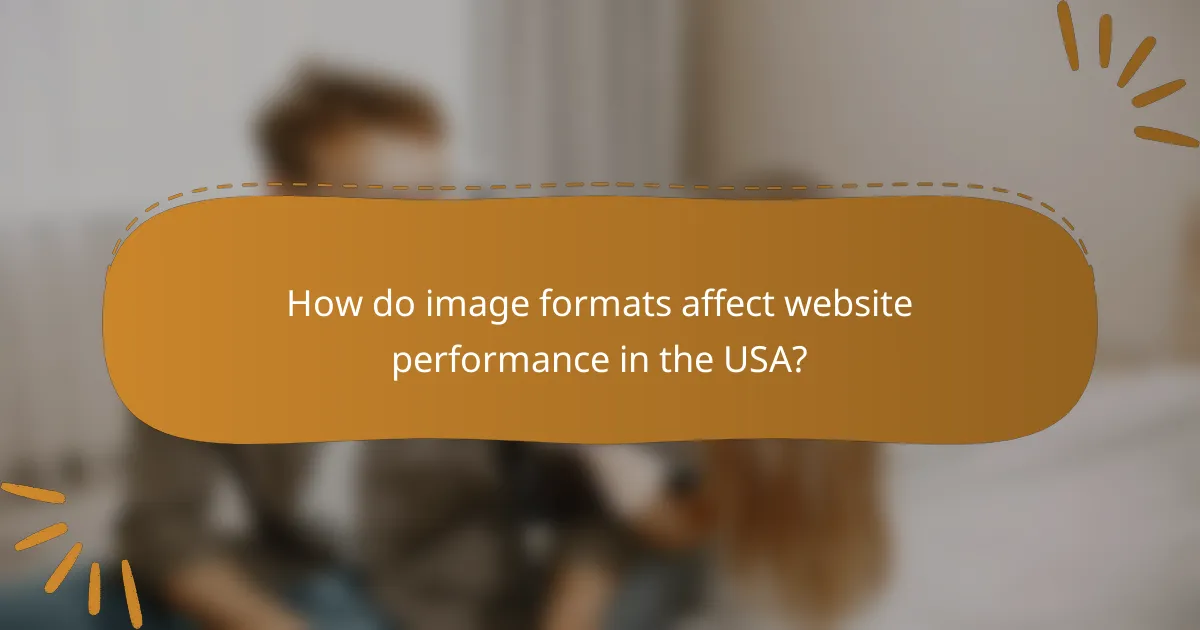Image formats play a crucial role in website performance, directly affecting load speed and user experience. Selecting the appropriate format can lead to reduced file sizes and improved visual quality, which are essential for keeping visitors engaged and boosting search engine rankings.

How do image formats affect website performance in the USA?
Image formats significantly impact website performance by influencing load speed and user experience. Choosing the right format can reduce file sizes, enhance visual quality, and improve loading times, which are crucial for retaining visitors and optimizing search engine rankings.
JPEG for high-quality images
JPEG is a popular format for high-quality images, especially photographs, due to its efficient compression. It typically achieves a balance between image quality and file size, making it ideal for websites that require detailed visuals without excessive loading times.
When using JPEG, aim for a quality setting between 70% and 85% to maintain a good visual experience while keeping file sizes manageable. This range often results in files that load quickly, enhancing overall site performance.
PNG for transparency
PNG is the go-to format for images that require transparency, such as logos and graphics with irregular shapes. Unlike JPEG, PNG supports lossless compression, ensuring that image quality is preserved, which is essential for branding and design consistency.
However, PNG files can be larger than JPEGs, so use them selectively. For simple graphics or images with text, PNG is ideal, while for complex images, consider using JPEG to optimize loading speed.
WebP for optimized loading
WebP is a modern image format that provides superior compression techniques, resulting in smaller file sizes without compromising quality. This format supports both lossy and lossless compression, making it versatile for various types of images.
Using WebP can lead to significant performance improvements, with file sizes often reduced by 25% to 34% compared to JPEG and PNG. However, ensure that your website supports WebP, as compatibility with older browsers may be limited. Implementing a fallback option for unsupported browsers can help maintain user experience.

What image formats improve user experience?
Using the right image formats can significantly enhance user experience by optimizing load speed and visual quality. Formats like JPEG, PNG, and WebP each have unique advantages that cater to different needs, such as compression efficiency and image clarity.
Responsive images for mobile
Responsive images are essential for mobile user experience, as they adapt to various screen sizes and resolutions. Using the srcset attribute allows browsers to select the most appropriate image based on the device’s capabilities, ensuring faster load times and reduced data usage.
Consider using formats like WebP for responsive images, as it provides superior compression without sacrificing quality. Aim for images that are no larger than necessary; typically, a width of 800-1200 pixels is sufficient for most mobile displays.
SVG for scalable graphics
SVG (Scalable Vector Graphics) is ideal for logos, icons, and illustrations due to its scalability without loss of quality. Unlike raster formats, SVG files are resolution-independent, making them perfect for high-DPI screens.
When using SVGs, ensure they are optimized to reduce file size and improve load speed. Tools like SVGO can help compress SVG files effectively. Keep in mind that while SVGs are great for graphics, they are not suitable for complex images like photographs.

How can image formats enhance load speed?
Choosing the right image formats can significantly improve load speed by reducing file sizes without sacrificing quality. Formats like WebP and AVIF offer better compression than traditional formats, leading to faster loading times and an enhanced user experience.
Compression techniques for faster loading
Compression techniques reduce the file size of images, which directly impacts load speed. Lossy compression, which removes some image data, is effective for web images, while lossless compression retains all data but results in larger files. Using tools like TinyPNG or ImageOptim can help achieve optimal compression.
When selecting a compression level, aim for a balance between quality and size. A reduction of 50-70% in file size is often achievable with minimal visible quality loss. Regularly testing images on different devices can ensure that the quality remains acceptable across platforms.
Lazy loading for images
Lazy loading is a technique that delays the loading of images until they are needed, which can significantly enhance page load speed. By only loading images that are currently in the viewport, websites can reduce initial load times and save bandwidth for users who do not scroll down the page.
Implementing lazy loading can be done using native HTML attributes like `loading=”lazy”` or through JavaScript libraries. This approach is particularly beneficial for pages with numerous images, such as galleries or blogs, as it minimizes the amount of data loaded at once.

What are the criteria for selecting image formats?
When selecting image formats, consider factors such as quality, file size, and compatibility with various web browsers. The right format can significantly enhance website performance and user experience while ensuring quick load speeds.
Quality vs. file size
Balancing image quality and file size is crucial for optimal web performance. Formats like JPEG offer good quality at smaller file sizes, making them suitable for photographs, while PNG provides higher quality for images with transparency but typically results in larger files.
For web use, aim for a file size under 100 KB for standard images to ensure quick loading. Tools like image compressors can help reduce file sizes without a noticeable loss in quality, allowing for faster page loads and improved user experience.
Browser compatibility considerations
Different browsers support various image formats, which can affect how images are displayed on your site. JPEG and PNG are widely supported across all major browsers, while newer formats like WebP provide superior compression but may not be compatible with older browsers.
To ensure a seamless experience, consider using fallback options. For instance, serve WebP images to browsers that support them while providing JPEG or PNG alternatives for those that do not. This strategy helps maintain quality and performance across diverse user environments.

What tools can optimize image formats?
Several tools can effectively optimize image formats to enhance website performance and user experience. These tools help reduce file sizes without significantly compromising quality, leading to faster load speeds and improved engagement.
Adobe Photoshop for editing
Adobe Photoshop is a powerful tool for editing images before optimization. It allows users to adjust dimensions, crop images, and apply various filters to enhance visual appeal. When saving images, selecting the appropriate format—such as JPEG for photographs or PNG for graphics—can significantly impact file size and quality.
To optimize images in Photoshop, use the “Save for Web” feature, which provides options to adjust quality settings and preview file sizes. This helps strike a balance between image quality and loading speed, ensuring a better user experience on your website.
TinyPNG for compression
TinyPNG is an online tool specifically designed for compressing PNG and JPEG images. It uses smart lossy compression techniques that reduce file sizes while maintaining visual quality. This tool is particularly useful for web developers looking to enhance site performance without sacrificing image clarity.
To use TinyPNG, simply upload your images, and the tool will automatically compress them. The resulting files are often reduced by 50-80%, making it an efficient solution for optimizing images for web use. Regularly compressing images before uploading can significantly improve load times and overall site responsiveness.

What are the emerging trends in image formats?
Emerging trends in image formats focus on enhancing website performance and user experience through improved compression and quality. Formats like AVIF are gaining traction, while artificial intelligence is increasingly used for image optimization.
Adoption of AVIF format
The AVIF format is becoming popular due to its superior compression capabilities compared to traditional formats like JPEG and PNG. It can reduce file sizes significantly while maintaining high image quality, which is crucial for faster load times on websites.
Web developers should consider using AVIF for images on their sites, especially for high-resolution visuals. However, compatibility with older browsers may be a concern, so it’s wise to implement fallback options for users with unsupported browsers.
Increased use of AI for image optimization
Artificial intelligence is transforming image optimization by automating the process of adjusting image sizes and formats based on user devices and connection speeds. This ensures that users receive the best possible experience without unnecessary delays.
Utilizing AI tools can help webmasters streamline their workflows and improve load speeds. It’s advisable to regularly review and update these tools to leverage advancements in AI technology, ensuring optimal performance and user satisfaction.
